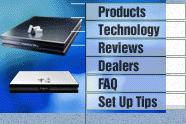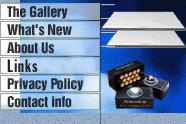|
|

Part 1: Professional Reviews. For Part 2, Feedback From Customers,please click here.
Segue ISO Isolation Platform
by Bruce Kinch, Positive Feedback Online Issue 77(read full review)
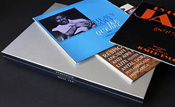
Excerpts from full review. To read FULL REVIEW, please click here.
"I made 24/96 dubs of select tracks of different configurations played at levels about 10 db higher than normal for initial comparisons. The Spacedeck with spacers directly on the undamped MDF shelf (i.e., analogous to generic metal cone footers) fared worst. It was easy to hear why the late Tom Fletcher, the Nottingham designer, employed the visco-elastic footers for isolation, and why he felt the expense of the sub-platform was justified by the increased isolation. However, upon replacing the stock platform with the Segue ISO, things got interesting. First, the Segue ISO proved superior to the stock platform in isolating the turntable from low frequency grunge - the Drum Record and the Cellists were noticeably tighter and cleaner, for example. Inserting the metal spacers particularly affected the spatial, dynamic, and resolution characteristics. The Spacedeck was not idly named, but the Segue ISO re-mapped the soundstage wider, higher, and deeper than ever before, be it the clang and rattle of the Wuorinen or the airy acoustic surrounding the Swedish choir and organ. The Segue ISO reveals that much of the criticism leveled at the Nottingham "sound"- a very slight tendency towards vagueness, blurred transients, muted dynamics - can be chalked up to the out-dated rubbery button footers. Simply put, the Segue ISO returns the once groundbreaking Nottingham Analogue design to contemporary high-end standards.
"
Symposium Acoustics Isis Rack
by Ernie Fisher, The Inner Ear Report vol. 15, #3
(http://www.innerear.on.ca)
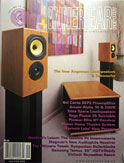
Excerpts from full review. To read FULL REVIEW, please click here.
"Although the system sounded very impressive without the Isis, the complete system now took on further dimensions, significantly more expansive, dramatic space/time improvements, better inner detail, better focus, better bass, but more than anything, a wide open sound that seemed to have been freed from confinement. The Editor called it "uncaged," but hastened to add that uncaged here means "controlled freedom" from sonic confinement. Though we were skeptical, the Isis' effectiveness was indisputable as the all-round sound opened up and allowed listeners to hear distinct improvements."
Svelte and Segue Platforms
by Andre Marc, Positive Feedback Online Issue 73(read full review)

Excerpts from full review. To read FULL REVIEW, please click here.
" Symposium Acoustics has made it clear to me that their suite of products is essential to maximizing the potential of any high end system. The company is not the flavor of the month, and they have continually looked to improve their products with an intelligent approach with the intention of solving real world problems, with proven theory, and experimentation.The Symposium product line up is varied, and it should not be difficult to find the solutions that are appropriate for your system. Even those with modest budgets can dip their toes in the water, as I did, several years ago. On the other end, the flagship Isis rack is a thing to behold. The products under review here, the Svelte Shelf, Svelte Plus, The Segue and the Segue ISO platforms, are home runs. I can't recommend them highly enough for a variety of applications."
Symposium Acoustics Ultra Platform
by John Marks, Stereophile Magazine Vol. 26 No. 3 (excerpts)
(http://www.stereophile.com)
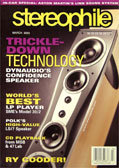
"...a few weeks ago my wife came home after working late, and while she and I were eating dinner, two rooms away our daughter was listening - not at all loudly - to Jennifer Warnes' Famous Blue Raincoat. My wife cocked her head and observed, "I've never heard that particular [vocal] swoop quite so clearly."
I chortled triumphantly. "While you were at work, a new isolation platform arrived for the [Marantz SA-14] SACD player, and I set it up."
"Oh just shut up," she explained.
My wife loves music but has a low tolerance level for audio tweakery and very expensive gear...I value her reactions in large part because she has absolutely no emotioal investment in a tweak's working or not. As important, just because something sounds different, she's not willing to give it the benefit of the doubt and assume that it sounds "better." Cases in point include the SACD of Glenn Gould's Goldberg Variations ("Is there something wrong with the system?") and a cryogenic-process experiment on an Arturo Delmoni CD ("It sounds like he's playing a viola in the fifth position").
...So her hearing from two rooms away the enhancement in resolving power and lowering of noise floor that I believed I heard after setting up Symposium Acoustics' Ultra isolation platform was quite gratifying.
...Despite clear evidence to the contrary, some people still maintain that factors such as vibration control cannot affect digital playback. Apart from the evidence of the ears of people who can hear, the science is indisputable: The Compact Disc is an analog medium that recovers by analog means data that are later treated as though they represent digital data. Just as the case with an LP turntable, attention to vibration control will yield sonic dividends."
Isis Platform and Rollerblock Jr.
by Rick Becker, EnjoyTheMusic.com (http://www.EnjoyTheMusic.com)
Excerpts from full review. To read FULL REVIEW, please click here or on picture below.
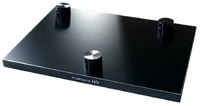
"...Each component in my system benefited from one Symposium product or another, and, in most cases, felt like a major upgrade of that component. It almost goes without saying that each Symposium product was far superior to any of the home-brew tweaks I had previously been using. So, you can start with one and move up to more when your finances or your spirit moves you. The value is certainly there. I expect you would have to spend many kilobucks on front end, amps and speakers to equal the improvements these products can make... and even if you tried, I'm not sure you could. It is like they say in the BASF commercial: "We don't make the product; we make the product better." Ditto, Symposium Acoustics."
Symposium Acoustics Energy Absorption Platform
by Michael Fremer, Stereophile Magazine Vol. 20 No. 5 (excerpts)
(http://www.stereophile.com)
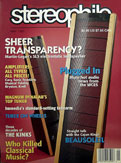
"...The standard-size Symposium board, with its gleaming aluminum surface, looks and feels impressive. Build quality is superb. The longer, wider, 55-lb TNT version is even more imposing, if not a bit clinical placed atop the Vibraplane. First, to reduce the variables, I listened to the TNT without the Flywheel: a clear-cut improvement in the bass, and even greater overall focus. With the Flywheel in place, the results were simply overwhelming. I have never heard such top-to-bottom authority, focus, and slam through my system. I mean, I was jazzed into a very-late-night listening session.
Needless to say, when a reporter from the Wall Street Journal's European edition visited for an upcoming story on the vinyl resurgence, I was ready for him! His awe was superseded only by mine as we spun hour after hour of vinyl, occasionally stopping for an LP/CD comparison. Davey Spillane's Atlantic Bridge? Wow! Classic's new three LP Dead Man Walking soundtrack? Yikes! The guy missed his first train out, and almost missed the second.
The efficacy of the Symposium Acoustics platform was easy to demonstrate. With the 'table stopped and the stylus in the groove, a sharp tap on the motor or Flyweel's surface- which had produced a warm thunk through the speakers when the TNT rested on the Big Foot- now yielded a barely audible pop on the Symposium platform. Tapping on the platform itself confirmed quite clearly how effective it is in absorbing and dissipating energy. You can feel it with your fingers..."
A New Approach to An Old Problem
by Myles Astor, Ultimate Audio Magazine Vol. 3 No. 1 (http://www.ultimateaudio.com)
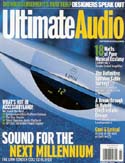
"Contrary to what the Beach Boys would have you believe, there is no such thing as good vibrations when it comes to high-end audio equipment. No part of the system, front-end, electronics or speakers, is immune to their insidious effects.
Symposium Acoustics' Ultra Platform and Rollerblock system is a rather ingenious and unorthodox approach to vibration isolation. The Ultra Platform consists of a constrained layer shelf constructed from (top to bottom) two layers of Al (0.05" anodized Al plus 0.125" Al), a 1/8 " mediating layer (a tempered hard board with a density between Al and MDF), 1.5" foam (non-resilient, closed cell, high thermal coefficient), 3/4" MDF, a 1/8" mediating layer and 0.05" Al. This "mirror imaging" construction (dense to less dense and back again) isolates the component against both floor borne and component generated vibrations.
The Rollerblocks make up the other half of the isolation system. They consist of two rectangular, drilled out and foam damped pieces of 7075 aircraft Al (with a machined metal cup) separated by either a standard chromium steel or tungsten carbide ball bearing. Three Rollerblocks are placed between the equipment and platform and according to the designer, help dissipate low frequency motion / vibration but preserve the energy transmission path. Placing the Rollerblocks underneath a component takes a little bit of practice and one should experiment with placement. The Ultra Platform and Rollerblocks can, depending on the weight of the component, provide isolation down to a few Hz (tiptoes by contrast, cut off around 10Hz).
Now I have problems with reviews of vibration isolation products that are written without a benchmark; for me, there isn't anything better (save for a Noise Block or Vibraplane) than the Goldmund cones. The system as reviewed consisted of Rollerblocks (I suggest springing for the tungsten carbide balls which lack the standard bearing's upper midrange illumination) placed between the digital player and the Ultra Platform; the Ultra Platform rested on Goldmund cones atop a Sound Anchors equipment stand.
The Symposium combo worked wonders under digital transports, processors or CD players. There was no doubt after switching back and forth that the Symposium combo went far beyond the Goldmund's capabilities. The system's noise floor was even lower. Recordings were more open, linear, and dynamic. Low frequencies were tighter and more detailed. The soundstage was better defined and images better focussed. I wouldn't be without the Symposium combo for reviewing digital components."
The Ultimate Tweak: Symposium Rollerblocks
by Ernie Fisher, The Inner Ear Report Vol. 12 No. 1 (excerpts)
(http://www.innerear.on.ca)

Excerpts from full review. To read FULL REVIEW, please click here.
"...In this business, hearing is believing; when it comes to accessories, the only qualifying requirement is an audible improvement. Our Editor has been saying for years that if you can hear it, get it, and if you can't, don't bother. The Rollerblocks offer such an incredible all-round improvement, that the question of hearing them is almost moot. All our panelists heard significant improvements, whenever and wherever we used the Rollerblocks...
...The soundstage also shot up by about 15 inches with more defined boundaries and more conspicuous front-to-back reach. Our panelists concluded that the Rollerblocks create a realistic, multi-dimensional listening environment comparable to a live performance on a stage. We placed the Rollerblocks under CD transports and players, a turntable, preamplifiers, even a tuner, and their audible benefits were recognized and appreciated every time they were used. All our panelists were surprised as the Rollerblocks were used in conjunction with one of our in-house solid, vibration-suppressing component stands which already addresses resonances quite effectively, but doesn't come anywhere near the caliber delivered by Symposium RBs.
...Be advised that all so-called tweaks make an audible difference in a set-up, but the primary objective should be sonic improvements and enhanced musical authenticity. The trick is to separate hyperbole from reality, benefits from overstatements and to understand that sonic modifications aren't always credible. Folks who have invested a lot of money in an audio system are usually experienced listeners who can perceive changes at once; and the Symposium Rollerblocks should be considered by anyone who has already aspired to the high-end of audio. However, those who have modest systems with which they are familiar, will also hear significant improvements, perhaps more so than a new amp or preamp can provide. Thus, the Symposium Rollerblocks function just like a component which can stand the test of time for they will never be obsolete."
Symposium Rollerblocks Series 2
by Sam Tellig, Stereophile Magazine Vol. 22 No. 4 (excerpts)
(http://www.stereophile.com)
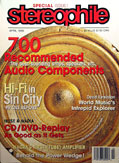
"So...do you want to squeeze out a few more bits?
Well, here's a way to get more resolution from the CD player you already have. Maybe. It worked for me, anyway.
My buddy the Brass Ear put me on to these. You can try a set of Symposium Rollerblocks under your CD player or transport. You could try a second set under your processor, too, if you get ambitious and have the dough.
Well, here's a way to get more resolution from the CD player you already have. Maybe. It worked for me, anyway...
...What do you get in your Rollerblock box? Three 'precision-machined' (they're not kidding) Rollerblock bodies; three chromium-steel or optional tungsten-carbide ½" bearings, and three stainless-steel RollerPlates, which you'll probably use only if your equipment has a textured, 'bumpy,' or ventilated bottom.
The Rollerblock bodies are rectangular blocks of extremely hard "alloy aircraft aluminum" finished with a black 'hard-coat' anodizing. The bottom of each block has four beveled edges and a matrix pattern of holes, said to improve mechanical coupling between the body of the block and its supporting service(sic).
...The things worked for me- in a big way- when I tried them under the Rotel and Denon players, and under my Panasonic A310 DVD player as well.
What happens?
I suggest you listen for yourself. And, as always when buying a costly accessory, get a money-back guarantee in case you don't hear-or see...improvement. But for me, with both CD players, resolution improved markedly.
No foolin'. The sound just tightens up, cleans up, clears up. I hear more low-level information. Imaging improves. Timing, too. Each player now lets go of the notes faster- there's less muddying of details. Transients are crisper. I hear improvement in just about every respect. 'Perfect' sound becomes more...well, perfect.
Drawbacks? Other than the fact that your wallet will be...lighter, your player might roll around a little on those ball bearings when you load a disc or press Play. But hey, with hi-fi there's almost never any gain without pain.
Under my DVD player, the Rollerblocks worked similar wonders. This time I could see as well as hear.
I know, I know- $220 [note: price has increased since review] worth of Rollerblocks under a $399 DVD player? But the picture did get sharper. Colors looked cleaner, more vivid. Even Marina noticed.
'What did you do to the DVD player? The picture improved.'
Peter Bizlewicz points out that Rollerblocks work most dramatically under digital equipment, but also under amplifiers, preamplifiers, and other equipment.
Try these if you dare!"
Symposium Ultra Platform, Rollerblocks with Grade 5 Superball, and Svelte Shelf
by Wing Cheung, Audiotechnique Magazine (Hong Kong)
(http://www.audiotechnique.com.hk)
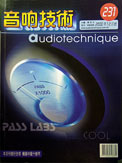

Please click here or on banner at right for full review in Chinese.
A Symphony of Symposium
by Steven R. Rochlin, EnjoyTheMusic.com (http://www.EnjoyTheMusic.com)
Excerpts from full review. To read FULL REVIEW, please click here or on picture below.
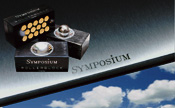
"...Moving back to my beloved Wavelength Audio Cardinal single-ended tube monoblocks, i tried the same Svelte Shelf on the bottom (sitting one each
on my two Target amplifier stands) with the upside-down Rollerblock technique.
Yes! This was really a revelation over various cones and pucks i have on hand.
WOW!!! Speed, precision and articulation... These are the three words that i
first wrote down in my notes. While my system does not suffer from
slowness, the Avantgarde Acoustic Duo hornspeakers will, and i do mean will
tell you everything. This seemed the be the "sweet spot" in the
Symposium Acoustics line. For me this was the best setup for my system without a
doubt. In fact i got lost for hours enjoying music from classical and jazz to my
fave 80's dance. In fact the Symposium Acoustics Svelte Shelf with Rollerblocks
is so good that this setup is not, i repeat not leaving my system. Sold!..."
Direct comparison of Rollerblocks to another bearing isolation device
by Srajan Ebaen, Soundstage.com (http://www.Soundstage.com)
Excerpts from full review. To read FULL REVIEW, please click here or on picture below.

"...Higher up in frequency response, the Rollerblocks created what seemed like sweetness in the upper midrange. In the context of this system, it made the previous setup seem slightly harder in that region. Think of the Symposium version more correctly as a subtraction of this subtle hardness, rather than the addition of a pleasing coloration. These devices also enhanced dynamic range, as though the outer limits between quiet and loud passages had been further stretched apart. In the treble, the added detail paid dividends in image precision and localization. Isolating components from each other and their support structures via the Rollerblocks decompresses the internal musical structure and releases more details, subtler inflections and finer gradations of tonal colors. Another way of describing these effect is an overt increase of resolution that removes spider webs, dust and crud from the sonic fabric. It won't take any glasses to notice, either. The effects are pronounced and accumulative.
Judging from the experience in my system, adding Rollerblocks from component to component simply intensifies the results. Whether that's universal (i.e., installed in various systems, could there be a limit as to how many components can be floated before you sonically take backwards steps?) I don't know. This is just another reminder that you need to try such tweaks first. Personally, I'm wholeheartedly endorsing Symposium's Rollerblocks and recommend that you evaluate a set in your own system at the earliest opportunity...."
Symposium Rollerblocks
by Blair Roger, @udiophilia.com (http://www.audiophilia.com)
Excerpts from full review. To read FULL REVIEW, please click here.
"...What the Rollerblocks do in practice is simply astonishing. I was loaned two sets of them, so I put the first ones under my Jadis Orchestra integrated amplifier. Tube amps are rife with vibrations from the transformers. Such vibrations are bound to cause microphonic effects in the power tubes, subtly blurring the sound. My first impression, listening to Miles Davis playing My Funny Valentine (Cookin' OJC-128), was of a vast drop in the noise floor. Suddenly the musicians stood out in their own space and instrumental timbres took on a new sweetness and richness. Strangely, the music seemed louder even though I hadn't changed the volume setting. Bass lines were more tightly defined and pitch was clearly better centered.
I put on a studio recording by the late jazz vocalist, Mel Torme from his album, Top Drawer (Concord Jazz CJ-219), that opens with a close-miked a capella passage. I listened to all the new details in articulation and to the harmonies of George Shearing on piano and Don Thompson on bass. The improvements were, once again, unmistakable. Then I put the second set of Rollerblocks under my Well-Tempered Turntable and played the record again. Suddenly, I could hear ambient reverberations in the a capella passage that weren't there before. I could hear the ambience of the studio that had been obscured by vibrations trapped in the plinth of the turntable. Torme's image took on an even more realistic presence, as new vocal details, like subtle sounds emanating from the throat, appeared for the first time. I turned to my listening partner and we both shook our heads and smiled.
...If you've been thinking about upgrading a major piece of equipment, especially one of the tubed or digital persuasion, try a set of Rollerblocks first. This is an incredibly good product: beautifully made and packaged, and a great value too. You will love the way this product reveals subtle recorded details, and sweetens the sound of your favorite recordings."
Rollerblocks
by John Marks, Planet Hi Fi
"Rollerblocks by Symposium Acoustics, (973) 616-4787, are component damping and isolation devices that are used in the same way as feet or cones, but with a pivotal (tee hee) difference: Rollerblocks are engineered to dissipate lateral motion as well. Shazam!
Each Rollerblock unit consists of a small, block-shaped aircraft aluminum support unit with a dished depression milled into the top, which is then polished to a mirror finish. Into the dished depression goes a chromium steel ball bearing about 10 mm in diameter. Tungsten carbide bearings are an optional upgrade. The standard set comes in an elegant wooden case with comprehensive instructions.
Three Rollerblocks support your CD player or other component. The weight of the component constrains the top surface of the ball bearing, so you don't have a banana-peel effect. The properly set up component can then rock 2-3 mm in all lateral directions. Internal channels milled into the base block in a honeycomb pattern, themselves filled with a proprietary damping compound, carry away the vibration.
Constrained spherical bearings have been around for nearly 100 years in structural engineering for buildings built where earthquakes happen, so this is not voodoo. The first time I saw Rollerblocks I was immediately impressed by the fanatical quality and engineering, and since then they have been improved!
I tried the Series 2 Rollerblocks under our Thorens Consequence CD player. The improvement in articulation, focus, and detail was immediate. And, unlike some very expensive cones we have tried here, the Rollerblocks did not tilt the tonal balance up, bleach out textures, or etch the edges of images. Rollerblocks improve musical articulation without messing up tonal balances, and I heartily recommend you audition them."
|
